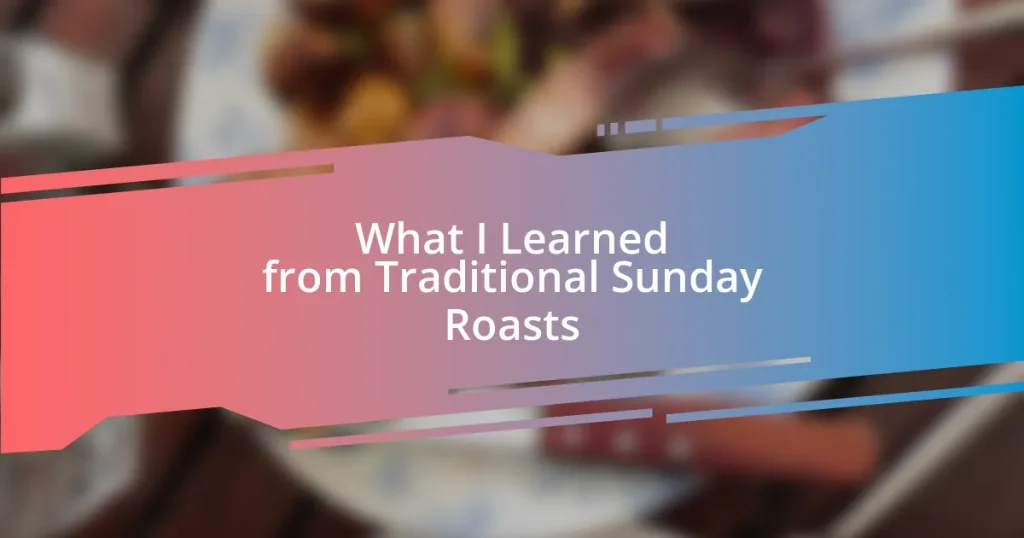Key takeaways:
- The Sunday roast tradition in British culture fosters family connections and creates lasting memories through shared meals.
- Key ingredients for a perfect roast include quality meat, root vegetables, crispy potatoes, rich gravy, and Yorkshire pudding, each contributing to the overall experience.
- Cooking techniques like slow-roasting, searing, and resting are essential for achieving tender and flavorful roasts.
- Accompaniments like fresh herbs and sauces enhance flavor, turning a simple meal into a vibrant culinary celebration.

Understanding Sunday Roast Tradition
The tradition of Sunday roast has deep roots, particularly in British culture. I remember my grandmother preparing for it every week, filling the house with the comforting aroma of roasting meat and vegetables. It’s this weekly ritual that brings families together, fostering a sense of connection and belonging—how special is that?
As I reflect on past Sunday roasts, I can’t help but think about the variety of dishes that honor this tradition. The perfect roast, crispy potatoes, and rich gravy are not just about taste, but also about the stories shared around the table. Have you ever found yourself reminiscing over a meal that held so much significance?
There’s something magical about the communal aspect of the Sunday roast. It invites pause in our busy lives, allowing us to gather, laugh, and share. I can vividly recall the lively conversations that often erupted, echoing the joy and warmth of togetherness. Isn’t it fascinating how a simple meal can strengthen bonds and create lasting memories?

Key Ingredients for Sunday Roast
The heart of any Sunday roast lies in its key ingredients, each playing a vital role in delivering that mouthwatering experience. Growing up, watching my mother season the meat with a pinch of love and a sprinkle of salt always struck me as art. The way she selected only the finest cuts turned a simple meal into a feast.
Here’s a quick rundown of essential ingredients:
- Meat: Typically beef, chicken, or lamb, tender and flavorful.
- Vegetables: Root vegetables like carrots, parsnips, and seasonal greens to complement the roast.
- Potatoes: Essential for crispy roasties, often seasoned with herbs.
- Gravy: A rich sauce made from the roasted meat drippings, elevating every bite with savory goodness.
- Yorkshire pudding: A light, airy side that’s a must if you’re serving beef.
Each of these elements contributes to a tapestry of flavors, memories, and traditions that keep me coming back for more. Just the smell of those roasted vegetables brings me back to Sunday afternoons filled with laughter and stories, a comforting reminder of home.

Cooking Techniques for Perfect Roast
Cooking techniques are crucial in achieving a perfect roast, and I’ve found that patience is key. One method I swear by is the slow-roast technique, where the meat is cooked at a lower temperature for a longer time. This ensures that it becomes tender and juicy while allowing the flavors to develop deeply. On a few occasions, I’ve roasted a shoulder of lamb slowly, and I recall the divine aroma wafting through my kitchen, making my family eager for dinner long before it was time to eat!
Another interesting technique is searing the meat before roasting. I learned that this step locks in juices and creates a delicious crust. The first time I tried this, the transformation was remarkable. I seared a beef joint on the stovetop before putting it into the oven, and it turned out to be the star of the meal, bursting with flavor and juiciness. I couldn’t help but smile when my guests commented on how extraordinary it was!
Finally, let’s not overlook the importance of resting the meat after it’s out of the oven. I remember once, in my eagerness, I sliced into a roast immediately, only to discover it was drier than I had hoped. Now, I always allow at least 20 minutes of rest, which gives the juices time to redistribute. After all, who doesn’t want to savor every succulent bite of their hard work?
| Cooking Technique | Description |
|---|---|
| Slow-Roasting | Cooking at a lower temperature for longer to enhance tenderness and flavor. |
| Searing | Quickly browning the meat before roasting to lock in juices and create a crust. |
| Resting | Letting the meat sit after cooking to allow juices to redistribute for maximum juiciness. |

Accompaniments that Enhance Flavor
To truly elevate a Sunday roast, the right accompaniments can make all the difference. I’ve found that a vibrant selection of condiments brings a party to the palate. For instance, a tangy homemade apple chutney can provide a brilliant contrast to the rich flavors of roasting meats. The first time I tasted this combination, it was like a light bulb went off in my head—I couldn’t believe how much it enhanced the overall experience!
Don’t underestimate the power of fresh herbs mixed into your vegetables or gravy. I remember one Sunday experimenting with rosemary and thyme tossed into the roasted potatoes. The fragrant aroma that enveloped my kitchen made it feel warm and inviting, and the flavors that danced through every bite made me question why I hadn’t done this sooner. It’s fascinating how something as simple as a sprinkle of herbs can transform a dish from ordinary to extraordinary.
And let’s talk about sauces; they can really tie the meal together. The first time I whipped up a good horseradish sauce to go with roast beef, I was amazed at how it heightened the flavors. Does anyone else out there love that sharp kick, or is it just me? It’s become a staple in my home, adding that perfect zing to complement the richness of the roast. Being able to experiment with flavor profiles over the years has turned my Sunday roast into a flavorful celebration—one that I eagerly look forward to every week!

Personal Reflections on Sunday Roasts
Gathering around a Sunday roast holds a special place in my heart. It’s a time when my family comes together, not just to eat, but to share stories and laughter. I remember vividly one rainy afternoon, the aroma of a slow-cooked roast filled our home, wrapping us in warmth. As we sat together, I realized it wasn’t just about the meal; it was the cherished connections formed around the table that made the experience unforgettable.
Thinking back, those Sunday roasts taught me patience and care. I vividly recall the excitement of preparing my first roast—nerves fluttering in my stomach as I navigated my way through the process. I almost forgot to put in the vegetables! Looking back, it was a joy to find comfort in each step, from the first slice of the meat to watching my family’s eyes light up at the first bite. It’s remarkable how food can create such emotional ties. Isn’t it fascinating how something as simple as roasted meat and potatoes can become a canvas for creating lasting memories?
I’ve come to appreciate the ritual of the Sunday roast more than any other meal. It reminds me to slow down from the hectic pace of life. Whether it’s watching the roast spin in the oven or eagerly anticipating that first taste of gravy, each moment feels significant. How many meals make you feel that way? Sunday roasts have become our family tradition, weaving together my favorite people and cherished flavors—an experience I wouldn’t trade for anything.

Lessons for Modern Family Gatherings
It’s fascinating how the lessons learned from traditional Sunday roasts can effortlessly translate into modern family gatherings. I recall one particularly lively dinner with my relatives, where we took turns bringing a dish. It was a beautiful chaos of flavors, and I realized that just like those roasts, the heart of a great gathering lies in everyone’s contribution. Have you ever experienced that infectious excitement when each dish tells a unique story? That’s what keeps everyone engaged and connected.
Another lesson that stands out to me is the significance of setting the mood. I remember once organizing a simple family brunch and lighting a few candles while playing soft music in the background. Immediately, the atmosphere shifted; it felt warmer and more inviting, almost like an extension of our Sunday rituals. Isn’t it interesting how ambiance can transform a meal from routine to memorable? A well-set table enhances not just the food but the experience itself.
Lastly, I’ve discovered the value of embracing imperfections during gatherings. I think of that one time the cheese platter I prepared was completely devoured before the main course—that was unexpected! Instead of feeling embarrassed, we all burst into laughter. It reminded me that the essence of family gatherings is not about perfection but about sharing joy and making unforgettable memories together. After all, isn’t it those little mishaps that often lead to the best stories?















